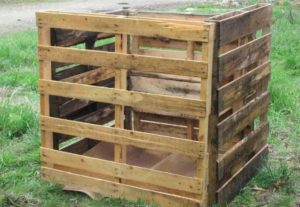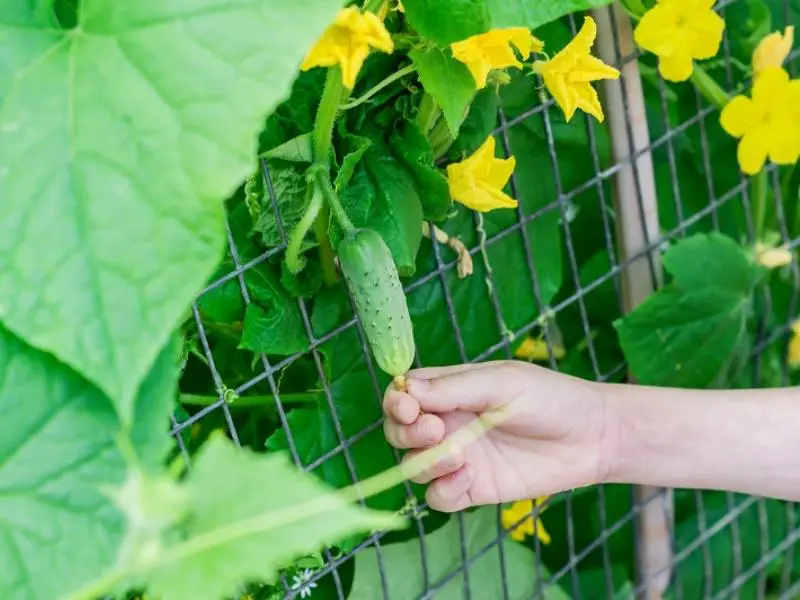
Cucumber plants grow upwards, climbing on a support structure, rather than spreading out over limited ground surface.
Growing cucumbers vertically is easy, provided they have adequate sunlight and water.
Follow these step-by-step instructions to learn how to grow cucumbers vertically in order to maximize limited space, reduce fungal diseases, make harvesting easier, and to transform your garden or balcony.
How to Grow Cucumbers Vertically (Step-by-Step)
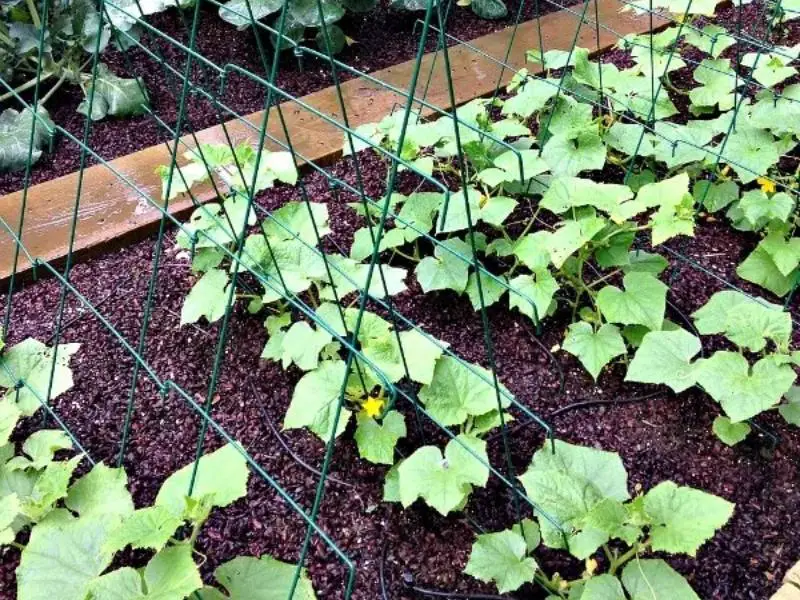
1. Choose the Best Spot and Container
Cucumbers thrive in warmth. Select a sunny spot that gets at least 6 hours of direct sunlight per day.
For container-grown vertical cucumbers, choose a container that is at least 12 inches wide and 12 inches deep to give the plant enough space to take root and grow. Place the container in a sunny spot.
2. Provide Support for Climbing
Vertically grown cucumbers grow on a vine and need to climb up a support structure, like a trellis, so choose a spot that allows space to erect a trellis.
As the plant grows, encourage it to climb the trellis by threading the vines through the trellis every week.
3. Improve the Soil Conditions
Cucumbers need soil with good drainage and a neutral pH of between 6 and 7. Adding compost to the soil provides nutrients that enhance growth.
4. Plant From Seed
Cucumbers grow best when planted from seed. Plant the seeds in a small pot, in 1-inch-deep holes, 2 inches apart. Place the pot in a sunny area.
After 7–10 days, stems and leaves will emerge through the soil. As soon as the seedlings are big enough to handle, transfer them to the selected spot where the vertical cucumber plant can mature.
Add some mulch around the base of the seedlings after planting them in the soil. Mulch protects the plants and prevents the soil from drying out.
5. Water
Cucumbers contain natural moisture and need a lot of water. For healthy plants with the best yield, water cucumbers every 3–4 days. In hot climates, or if the temperature rises to 90°F, water cucumbers every day.
Test if your cucumbers need watering by inserting a finger 1 inch deep into the soil. If the soil feels dry it is time to water the plant.
6. Add Fertilizer
Fertilizer helps a vertical cucumber plant to grow healthily and give a plentiful yield of plump, luscious fruit.
Add fertilizer to the soil when planting the seedlings, and again when the plants reach 12 inches in height.
Fertilizer contains three main nutrients, namely nitrogen, phosphorus, and potassium. Use 10-10-10 (i.e., 10% each of nitrogen, phosphorus, and potassium) or 10-20-10 fertilizer on cucumber plants for healthy growth.
Follow the instructions on the bag when adding the fertilizer to the soil.
7. Harvesting the Cucumbers
Vertically grown cucumbers are ready for harvesting 3 months after planting. Harvest cucumbers that look full and plump, are dark green in color, and feel firm to the touch.
Don’t allow the cucumbers to become over-ripe and soft.
Troubleshooting & Tips for Success
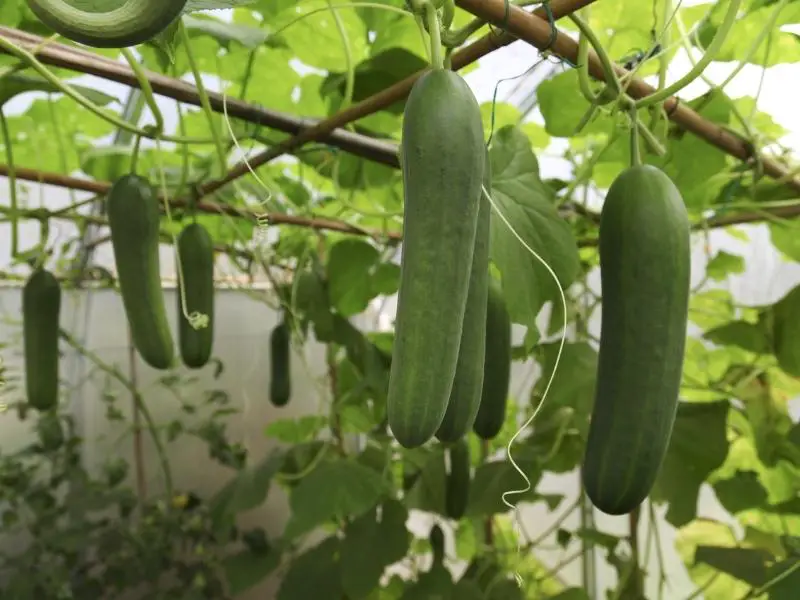
Although it is easy to grow cucumbers vertically, problems do sometimes arise. Follow these tips for the best growing success:
Position
When planting cucumbers vertically, the right position is crucial for healthy growth. Cucumbers need a minimum of six hours of direct sunlight per day, but they also wilt easily if overexposed to harsh sun.
The ideal position is in a location where the plant receives full sun in the morning and partial shade during the hottest part of the afternoon.
Soil
Cucumbers don’t do well in soil that is too acidic or too alkaline. Keep the pH neutral at 6.5–7. Check the approximate pH of the soil by doing this simple home-test:
To Test for Soil Alkalinity
Place ¼ cup of soil in a small dish and add ½ cup of white household vinegar. If the soil foams, the pH is high and the soil is alkaline.
To Test for Soil Acidity
Place ¼ cup of soil in a small dish. Add enough distilled water to dampen the soil, and add ½ cup of baking soda. If the soil foams, the pH is low and the soil is acidic.
Watering
Take care not to overwater a vertical cucumber plant. Overwatering causes root rot, which can kill the plant.
Avoid watering the leaves of the cucumber plant. Excess moisture on the leaves causes fungal growth which is harmful to the plant.
Fertilizer
Water-soluble fertilizer is fertilizer that dissolves as you water the plant. The water solubility of this fertilizer improves the nutrient uptake by the roots of vertical cucumber plants.
Diseases
Cucumbers are prone to fungal diseases like mildew. Fungal growth sets in when the leaves of the plant are constantly damp. Avoid watering the foliage to prevent fungal disease.
Signs of Fungal Disease
White, powdery patches on the plant’s leaves are an indication of fungal disease. The fungus isn’t likely to spread to the cucumbers themselves, but, if left untreated, the leaves will fall off, exposing the fruit to the harsh sun and causing sunburn and eventual death.
Treating Fungal Disease
The most effective treatment for fungal disease in cucumber plants is to spray the leaves with a solution of baking soda and water.
Pour one liter of water into a spray bottle and add 2 teaspoons of baking soda. Spray the solution on the leaves and repeat the treatment after one week if the problem persists.
Trellis Types
A free-standing A-frame trellis works well to grow cucumbers vertically. Ensure that the frame is at least 6 feet tall and is stable and can’t topple over.
The most supportive arrangement for vertical cucumber plants is a trellis secured to a wall.
Pruning
Vertical cucumber plants grow prolifically and need pruning to prevent the vine growth from overtaking the fruit production.
During the growing season, lightly trim the outside branches and leaves every 5–6 weeks.
Benefits of Growing Cucumbers Vertically
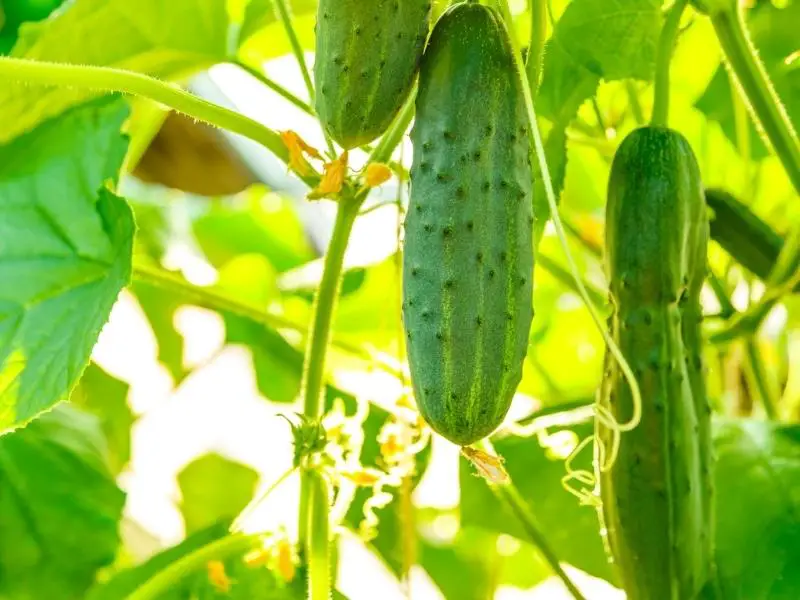
There are many benefits to growing cucumbers vertically:
Space-Saving
Small gardens or apartment balconies are good spaces for growing cucumbers vertically because this style of garden doesn’t take up much space.
Vertically grown cucumber plants provide a bountiful crop from a limited amount of space.
Avoiding Fruit Rot
Because the fruit of vertically grown cucumber plants hangs down rather than lying on the ground, more air circulates around the hanging fruit, making the fruit less likely to rot.
Avoiding Fungal Disease
Fungal disease sets in when the plant is constantly damp. Horizontally grown plants don’t offer much opportunity for moisture to evaporate, leaving the plant a perfect breeding place for moisture-adept diseases.
Growing cucumbers vertically helps to prevent fungal disease by allowing the plant to dry out fully as the vines climb the support structure.
Ease of Harvesting
Harvesting vertically grown cucumbers is easy because the fruit is above ground level, and you don’t need to bend over and rummage through the foliage to get to the fruit.
The cucumbers hang on the vines and are easy to pick when ripe.


